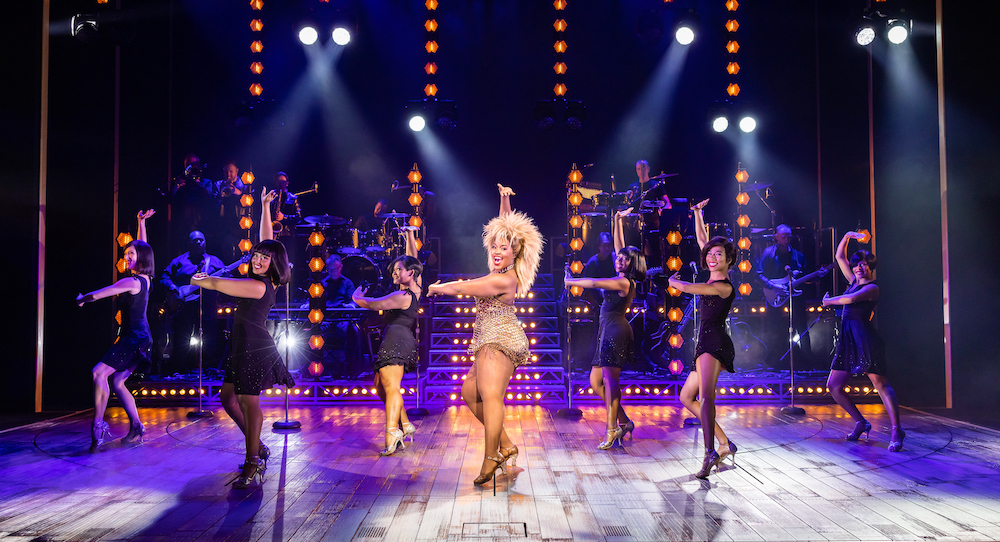Theatre Royal, Sydney.
17 May 2023.
Born in Nutbush, Tennessee, in 1939, Anna Mae Bullock grew up through the racial turmoil of the mid-20th century, to become one of the biggest music stars of the second half of the century, continuing well into the 2000s, as household name Tina Turner. Turner’s music has permeated the top echelons of entertainment, sport and media, with most of us who grew up learning dance having done at least one routine to any number of the showstopping hits she recorded, such as “Disco Inferno” (written by Ron Kersey and Leroy Green) or “Proud Mary” (written by John Fogarty), and most everyone has boogied on a wedding dance floor to a Turner’s own 1973 hit “Nutbush City Limits,” a homage to the town where she was born and spent her early years.
TINA: The Tina Turner Musical, written by Katori Hall, is a jukebox musical at its core, telling the songstress’ story, including many a song she made truly famous, with her gutsy showstopping vocals, unique sound and style. Turner had a rough ride early in life, with abusive parents who both abandoned her, and then a life that on stage was magical but behind the scenes wrought with domestic and financial abuse at the hands of her first husband and on-stage partner/manager, Ike Turner. This show does not shy away from these difficult topics, and has a raw edge about it, as if you are sitting listening to Tina tell her actual story in a montage, not a Hollywoodized version of events. In this way, it is rather confronting, albeit very real. It does not hide us from the uncomfortable and often ugly reality of the life lived by this woman, who has succeeded and pushed forward against all odds. It is a not a pretty telling of the tale.
With so many wonderful songs that help to tell this story, it is hard to sit still in your seat, and every restraint is needed to keep from singing along. An incredibly talented cast, led by the amazing vocals of Ruva Ngwenya (Tina Turner) and Tim Omaji (Ike Turner), the cast builds up each number to go from strength to strength. Rebecca Selley, Jayme-Lee Hanekom and Emily Nkomo play the Ikettes, and later as Tina’s backing vocal team, have harmonies that hit the spot, alongside and an ensemble that have all the energy. A gifted Young Tina (Amara Kavaliku in this cast) came out at the end and belted out with Ngwenya in one of the final numbers, “The Best,” and it was obvious in this moment that the future of theatre in this country is bright. At the end of the show, this song, and this moment, is rather triumphant, celebrating the rock concert style Turner is most famous for, and the atmosphere of the huge crowds she drew. The audience is encouraged to get up, sing, dance and finally let out what we have been holding in the whole time.
The lighting throughout the show (originally by Bruno Poet, Australian associate lighting design by Kathy Pineo) creatively captures the various transitions, from a cotton fields/historical small town America feel, to the recording studio vibe, to live performance in Vegas, to the switch to arena concert style for the final numbers, the lighting created an atmosphere and design that transported the show through a vast array of concepts, carrying the visual elements to the heights. The music was also brilliantly mixed (arrangements by Nicholas Skilbeck, design by Nevin Steinberg, Australian associated sound design by Shelly Lee), bringing a richness and tone to the sound that only a theatre can really do, and each with each new song, the finer details in the score were clearly heard and experienced.
Choreographically, the opening had a soulful Ailey/The Colour Purple feel, drawing from artistic expressions of African American heritage, creating a montage-like impression of the cotton fields, moving into a gospel church, showing Anna Mae as Turner’s younger self already a passionate singer and personality from a young age. We see the choreography for TINA (Anthony Van Laast) evolve as the work progresses through the decades and the musical genres fly by, Turner herself developing from being a celebrated R&B artist, to her true passion, rock ’n’ roll. An interesting thing to note is that Turner did her own choreography. The Australian producer who picked her up and promoted her into solo performer stardom later in life, Roger Davies (played by Mat Verevis), tried to get her a choreographer, but in true Turner fashion, turned him down and insisted on creating her own choreographic work. The movement in TINA certainly has an organic feeling about it, not polished, but expressive and ultimately in tune with how one might feel if they were to allow themselves to just let go and move freely with the music. It is refreshing to see something authentic and not too contrived by the way of choreography. It is not clever or overtly crafted, born out of the way the artist wants to move to her own music, with an influence that clearly shows the era.
TINA is an iconic show about the life of an incredibly iconic woman and musical superstar, scars and all. It does not shy away from uncomfortable realities, and showcases some of the most famous songs that span the decades of her illustrious career. There is something in this show for everyone, containing currency and nostalgia all wrapped up in one. It is entertaining, moving and triumphant. It should not be missed.
By Linda Badger of Dance Informa.















